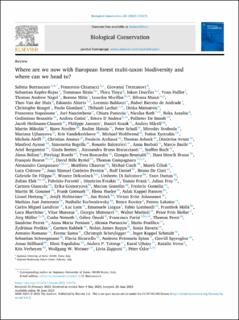| dc.contributor.author | Burrascano, Sabina | |
| dc.contributor.author | Chianucci, Francesco | |
| dc.contributor.author | Trentanovi, Giovanni | |
| dc.contributor.author | Kepfer-Rojas, Sebastian | |
| dc.contributor.author | Sitzia, Tommaso | |
| dc.contributor.author | Tinya, Flóra | |
| dc.contributor.author | Doerfler, Inken | |
| dc.contributor.author | Paillet, Yoan | |
| dc.contributor.author | Nagel, Thomas Andrew | |
| dc.contributor.author | Mitic, Bozena | |
| dc.contributor.author | Morillas, Lourdes | |
| dc.contributor.author | Munzi, Silvana | |
| dc.contributor.author | van der Sluis, Theo | |
| dc.contributor.author | Alterio, Edoardo | |
| dc.contributor.author | Balducci, Lorenzo | |
| dc.contributor.author | de Andrade, Rafael Barreto | |
| dc.contributor.author | Bouget, Christophe | |
| dc.contributor.author | Giordani, Paolo | |
| dc.contributor.author | Lachat, Thibault | |
| dc.contributor.author | Matosevic, Dinka | |
| dc.contributor.author | Napoleone, Francesca | |
| dc.contributor.author | Ódor, Péter | |
| dc.contributor.author | Nascimbene, Juri | |
| dc.contributor.author | Paniccia, Chiara | |
| dc.contributor.author | Roth, Nicolas | |
| dc.contributor.author | Aszalós, Réka | |
| dc.contributor.author | Brazaitis, Gediminas | |
| dc.contributor.author | Cutini, Andrea | |
| dc.contributor.author | D'Andrea, Ettore | |
| dc.contributor.author | De Smedt, Pallieter | |
| dc.contributor.author | Heilmann-Clausen, Jacob | |
| dc.contributor.author | Janssen, Philippe | |
| dc.contributor.author | Kozák, Daniel | |
| dc.contributor.author | Mårell, Anders | |
| dc.contributor.author | Mikoláš, Martin | |
| dc.contributor.author | Nordén, Björn | |
| dc.contributor.author | Matula, Radim | |
| dc.contributor.author | Schall, Peter | |
| dc.contributor.author | Svoboda, Miroslav | |
| dc.contributor.author | Ujházyová, Mariana | |
| dc.contributor.author | Vandekerkhove, Kris | |
| dc.contributor.author | Wohlwend, Michael | |
| dc.contributor.author | Xystrakis, Fotios | |
| dc.contributor.author | Aleffi, Michele | |
| dc.contributor.author | Ammer, Christian | |
| dc.contributor.author | Archaux, Frédéric | |
| dc.contributor.author | Asbeck, Thomas | |
| dc.contributor.author | Avtzis, Dimitrios N. | |
| dc.contributor.author | Ayasse, Manfred | |
| dc.contributor.author | Bagella, Simonetta | |
| dc.contributor.author | Balestrieri, Rosario | |
| dc.coverage.spatial | Europe | en_US |
| dc.date.accessioned | 2023-07-04T08:31:33Z | |
| dc.date.available | 2023-07-04T08:31:33Z | |
| dc.date.created | 2023-07-03T13:49:55Z | |
| dc.date.issued | 2023 | |
| dc.identifier.issn | 0006-3207 | |
| dc.identifier.uri | https://hdl.handle.net/11250/3075479 | |
| dc.description.abstract | The European biodiversity and forest strategies rely on forest sustainable management (SFM) to conserve forest biodiversity. However, current sustainability assessments hardly account for direct biodiversity indicators. We focused on forest multi-taxon biodiversity to: i) gather and map the existing information; ii) identify knowledge and research gaps; iii) discuss its research potential. We established a research network to fit data on species, standing trees, lying deadwood and sampling unit description from 34 local datasets across 3591 sampling units. A total of 8724 species were represented, with the share of common and rare species varying across taxonomic classes: some included many species with several rare ones (e.g., Insecta); others (e.g., Bryopsida) were represented by few common species. Tree-related structural attributes were sampled in a subset of sampling units (2889; 2356; 2309 and 1388 respectively for diameter, height, deadwood and microhabitats). Overall, multitaxon studies are biased towards mature forests and may underrepresent the species related to other developmental phases. European forest compositional categories were all represented, but beech forests were overrepresented as compared to thermophilous and boreal forests. Most sampling units (94%) were referred to a habitat type of conservation concern. Existing information may support European conservation and SFM strategies in: (i) methodological harmonization and coordinated monitoring; (ii) definition and testing of SFM indicators and thresholds; (iii) data-driven assessment of the effects of environmental and management drivers on multi-taxon forest biological and functional diversity, (iv) multi-scale forest monitoring integrating in-situ and remotely sensed information. Forest biodiversity Multi-taxon Sustainable management Biodiversity conservation Forest stand structure | en_US |
| dc.language.iso | eng | en_US |
| dc.rights | Attribution-NonCommercial-NoDerivatives 4.0 Internasjonal | * |
| dc.rights.uri | http://creativecommons.org/licenses/by-nc-nd/4.0/deed.no | * |
| dc.subject | Forest biodiversity | en_US |
| dc.subject | Multi-taxon | en_US |
| dc.subject | Sustainable management | en_US |
| dc.subject | Biodiversity conservation | en_US |
| dc.subject | Forest stand structure | en_US |
| dc.title | Where are we now with European forest multi-taxon biodiversity and where can we head to? | en_US |
| dc.title.alternative | Where are we now with European forest multi-taxon biodiversity and where can we head to? | en_US |
| dc.type | Peer reviewed | en_US |
| dc.type | Journal article | en_US |
| dc.description.version | publishedVersion | en_US |
| dc.rights.holder | © 2023 The Authors | en_US |
| dc.subject.nsi | VDP::Zoologiske og botaniske fag: 480 | en_US |
| dc.subject.nsi | VDP::Zoology and botany: 480 | en_US |
| dc.source.journal | Biological Conservation | en_US |
| dc.identifier.doi | 10.1016/j.biocon.2023.110176 | |
| dc.identifier.cristin | 2160375 | |
| dc.relation.project | EU – Horisont Europa (EC/HEU): COST Action CA18207 | en_US |
| dc.source.articlenumber | 110176 | en_US |
| cristin.ispublished | true | |
| cristin.fulltext | original | |
| cristin.fulltext | original | |
| cristin.qualitycode | 2 | |

